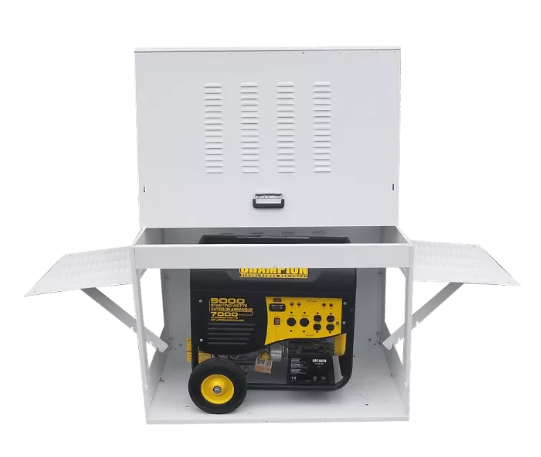Portable generators are invaluable tools for providing backup power during emergencies or for powering remote locations. However, they can be noisy, bulky, and vulnerable to weather elements when left outdoors. To address these challenges, many generator owners opt for metal portable generator enclosures. In this comprehensive guide, we’ll explore the benefits of metal enclosures for portable generators, the considerations for choosing the right enclosure, and the steps to install and maintain it effectively.
Understanding Metal Portable Generator Enclosures
What is a Metal Portable Generator Enclosure?
A metal portable generator enclosure is a protective structure made of metal materials, such as steel or aluminum, designed to house and shield a portable generator from external elements. These enclosures are typically equipped with ventilation systems, access doors, and other features to ensure proper operation and maintenance of the generator while providing protection from weather, theft, and vandalism.
Benefits of Metal Enclosures
Durability: Metal enclosures offer superior durability and resistance to weather elements, corrosion, and physical damage compared to other enclosure materials such as plastic or fabric.
Security: Metal enclosures provide added security by protecting the generator from theft, tampering, and vandalism, especially when equipped with locking mechanisms and reinforced construction.
Noise Reduction: Metal enclosures can help reduce generator noise levels by providing a barrier that absorbs and deflects sound waves, creating a quieter operating environment for nearby residents or occupants.
Factors to Consider When Choosing a Metal Portable Generator Enclosure
Size and Compatibility
Ensure that the enclosure is appropriately sized to accommodate your portable generator model and any additional equipment, such as fuel tanks or accessories. Consider the dimensions of the generator and the space required for ventilation, maintenance, and access when choosing the enclosure size.
Material and Construction
Opt for high-quality metal materials, such as steel or aluminum, with a durable and weather-resistant finish. Look for features such as welded seams, reinforced corners, and corrosion-resistant coatings to ensure the longevity and integrity of the enclosure.
Ventilation and Cooling
Ensure that the enclosure provides adequate ventilation and cooling to prevent overheating and maintain optimal operating conditions for the generator. Look for vents, louvers, or exhaust fans that allow for proper airflow while keeping out rain, snow, and debris.
Noise Reduction Features
Consider additional noise reduction features, such as sound-absorbing insulation or acoustic panels, to minimize generator noise levels and create a quieter operating environment.
Installing a Metal Portable Generator Enclosure
Site Preparation
Choose a suitable location for the generator enclosure, ensuring it is level, stable, and easily accessible for maintenance and fueling. Clear any debris, vegetation, or obstacles that may obstruct airflow or access to the generator.
Assembly and Installation
Follow the manufacturer’s instructions carefully to assemble and install the metal enclosure securely. Use appropriate tools and fasteners to ensure a tight and stable fit, and consider hiring professional installation services if needed.
Ventilation and Electrical Connections
Install ventilation openings or exhaust fans as per the manufacturer’s recommendations to ensure proper airflow and cooling for the generator. Connect electrical components, such as power cords or outlets, according to local building codes and safety standards.
Maintaining a Metal Portable Generator Enclosure
Regular Inspection
Perform routine inspections of the enclosure to check for signs of damage, corrosion, or wear and tear. Replace any damaged or worn components, such as seals, hinges, or locks, to maintain the integrity and security of the enclosure.
Cleaning and Maintenance
Clean the enclosure regularly to remove dirt, dust, and debris that may accumulate on the surface. Use mild detergent and water to clean the exterior, and avoid abrasive cleaners or solvents that may damage the finish.
Lubrication and Rust Prevention
Apply lubricants to hinges, locks, and moving parts as needed to ensure smooth operation and prevent corrosion. Consider applying rust-resistant coatings or paints to the metal surfaces to protect against rust and corrosion over time.
Conclusion
Metal portable generator enclosures offer a durable, secure, and efficient solution for protecting portable generators from external elements while minimizing noise levels and ensuring optimal performance. By choosing the right enclosure size, material, and features, installing it correctly, and maintaining it regularly, generator owners can enjoy peace of mind knowing that their generator is protected and ready to provide reliable backup power whenever needed. With proper care and attention, a metal enclosure can extend the lifespan of the generator and enhance its functionality for years to come.

